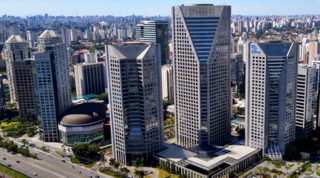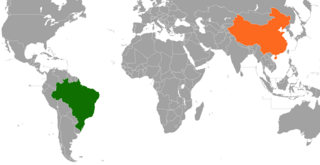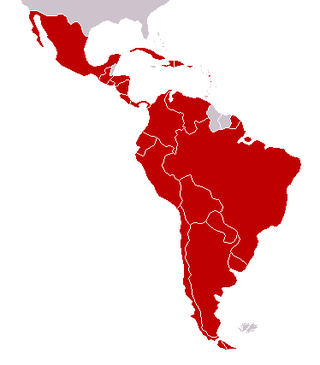Related Research Articles

The economy of Brazil is historically the largest in Latin America and the Southern Hemisphere in nominal terms. The Brazilian economy is the second largest in the Americas. It is an upper-middle income developing mixed economy. In 2023, according to International Monetary Fund (IMF), Brazil has the 9th largest gross domestic product (GDP) in the world and has the 8th largest purchasing power parity in the world.

The Ministry of Foreign Affairs is responsible for managing the foreign relations of Brazil. Brazil is a significant political and economic power in Latin America and a key player on the world stage. Brazil's foreign policy reflects its role as a regional power and a potential world power and is designed to help protect the country's national interests, national security, ideological goals, and economic prosperity.

The economy of South America comprises approximately 434 million people living in twelve nations and three territories. It encompasses 6 percent of the world's population.

The National Bank for Economic and Social Development is a development bank structured as a federal public company associated with the Ministry of the Economy of Brazil. The stated goal is to provide long-term financing for endeavors that contribute to the country's development. BNDES is one of the largest development banks in the world. Its non-performing loan ratio is also less favorable (2.2%) compared to the CDB's that stands below 1%.

Brazil is the 10th largest energy consumer in the world and the largest in South America. At the same time, it is an important oil and gas producer in the region and the world's second largest ethanol fuel producer. The government agencies responsible for energy policy are the Ministry of Mines and Energy (MME), the National Council for Energy Policy (CNPE), the National Agency of Petroleum, Natural Gas and Biofuels (ANP) and the National Agency of Electricity (ANEEL). State-owned companies Petrobras and Eletrobras are the major players in Brazil's energy sector, as well as Latin America's.
The North–South express railway is a proposed high speed railway in Vietnam. The line would begin in Lạng Sơn, crossing Bắc Giang, Bắc Ninh, Hanoi, Hà Tây, Hà Nam, Ninh Bình, Thanh Hóa, Nghệ An, Hà Tĩnh, Quảng Bình, Quảng Trị, Thừa Thiên-Huế, Đà Nẵng, Quảng Nam, Quảng Ngãi, Bình Định, Phú Yên, Khánh Hòa, Ninh Thuận, Bình Thuận, Đồng Nai, Bình Dương, Ho Chi Minh City, Long An, Tiền Giang, Vĩnh Long, Cần Thơ, Hậu Giang, Sóc Trăng, Bạc Liêu and ending in Cà Mau. The rail line would connect the two most urbanised areas in Vietnam, Hanoi in the North's Red River Delta in and Ho Chi Minh City in the South's Mekong River Delta. The total proposed length would be 2,070 kilometres (1,290 mi), compared with the 1,726-kilometre (1,072 mi) of the old railway line. The cost of the line is estimated at US$55.85 billion, to be funded by official development assistance from Japan and by the Vietnamese government itself. The project is planned to be implemented in three phases: Lang Son to Hanoi (170 km); Hanoi to Vinh city (285 km); Vinh City to Nha Trang (896 km); Nha Trang to Ho Chi Minh City (364 km); Ho Chi Minh City to Can Tho (139 km); Can Tho to Ca Mau (216 km). Construction activities on the first phase are expected to commence in 2020, and the whole project is scheduled for completion in 2050. This project is part of the country's railway transport development strategy by 2020 with a vision to 2050. The project is also part of the Trans-Asian railway network.

Brazil–China relations are the current and historical relationship between Brazil and China. Relations between Brazil and China began in the early nineteenth century and continued until 1949, when they were disrupted by the creation of the People's Republic of China (PRC). Diplomatic relations between the PRC and Brazil officially began in 1974 with agreement on the establishment and operation of Brazil's embassy in Beijing and China's embassy in Brasília. Since then, bilateral ties have developed mostly based on non-interference, equality, and mutual benefit (win-win).

People's Republic of China–Ethiopia relations were established in 1970. Ethiopia has an embassy in Beijing and the People's Republic of China has an embassy in Addis Ababa.

BRICS is an intergovernmental organization comprising Brazil, Russia, India, China, South Africa, Egypt, Ethiopia, Iran, Saudi Arabia and the United Arab Emirates. It was formed in 2010 by the addition of South Africa to its predecessor called BRIC named after first letter of founding countries Brazil, Russia, India, and China. In August 2023, at the 15th BRICS Summit, South African President Cyril Ramaphosa announced that Argentina, Egypt, Ethiopia, Iran, Saudi Arabia and the United Arab Emirates had been invited to join the organisation on 1 January 2024. However, on 30 December 2023, Argentina's new government officially withdrew the country from the application process and declined the extended invitation to join the bloc.
The China-ASEAN Investment Cooperation Fund, also knowns as the China Asean Fund or CAF, is a USD-denominated offshore multilateral cooperation fund majority owned by financial institutions of the Government of the People's Republic of China. It invests throughout Southeast Asia, which the fund defines as including China.

The New Development Bank (NDB), formerly referred to as the BRICS Development Bank, is a multilateral development bank established by the BRICS states (Brazil, Russia, India, China and South Africa). According to the Agreement on the NDB, "the Bank shall support public or private projects through loans, guarantees, equity participation and other financial instruments." Moreover, the NDB "shall cooperate with international organizations and other financial entities, and provide technical assistance for projects to be supported by the Bank."
Chinese foreign aid may be considered as both governmental (official) and private development aid and humanitarian aid originating from the People’s Republic of China.

The Belt and Road Initiative, known within China as the One Belt One Road or OBOR/1B1R for short, is a global infrastructure development strategy adopted by the Chinese government in 2013 to invest in more than 150 countries and international organizations. It is considered a centerpiece of the Chinese leader Xi Jinping's foreign policy. The BRI forms a central component of Xi's "Major Country Diplomacy" strategy, which calls for China to assume a greater leadership role for global affairs in accordance with its rising power and status. It has been compared to the American Marshall Plan. As of August 2023, 155 countries were listed as having signed up to the BRI. The participating countries include almost 75% of the world's population and account for more than half of the world's GDP.

Latin America as a region has multiple nation-states, with varying levels of economic complexity. The Latin American economy is an export-based economy consisting of individual countries in the geographical regions of North America, Central America, South America, and the Caribbean. The socioeconomic patterns of what is now called Latin America were set in the colonial era when the region was controlled by the Spanish and Portuguese empires. Up until independence in the early nineteenth century, colonial Latin American regional economies thrived and worked things out. Many parts of the region had favorable factor endowments of deposits of precious metals, mainly silver, or tropical climatic conditions and locations near coasts that allowed for the development of cane sugar plantations. In the nineteenth century following independence, many economies of Latin America declined. In the late nineteenth century, much of Latin America was integrated into the world economy as an exporter of commodities. Foreign capital investment, construction of infrastructure, such as railroads, growth in the labor sector with immigration from abroad, strengthening of institutions, and expansion of education aided industrial growth and economic expansion. A number of regions have thriving economies, but "poverty and inequality have been deeply rooted in Latin American societies since the early colonial era."

The Three Seas Initiative, known also as the Baltic, Adriatic, Black Sea (BABS) Initiative or simply as the Three Seas, is a forum of thirteen states, in the European Union, running along a north–south axis from the Baltic Sea to the Adriatic and Black Seas in Central and Eastern Europe. The Initiative aims to create a regional dialogue on questions affecting the member states.
The China-LAC Cooperation Fund is a multilateral investment and financing cooperation fund established by the Chinese government. The CLAC Fund is divided into a US$2 billion co-financing facility and US$3 billion investment fund. Both the co-financing facility and fund support investments and projects in Latin America and the Caribbean.
The Sino-Latin American Production Capacity Cooperation Investment Fund is a multilateral cooperation fund established by the Chinese government to support investments by Chinese companies in Latin America.
Green finance is officially promoted as an important feature of the Belt and Road Initiative, China's signature global economic development initiative. The official vision for the BRI calls for an environmentally friendly "Green Belt and Road".
References
- 1 2 "Brazil, China open $20 billion fund for infrastructure, tech projects". No. June 27, 2017. Archived from the original on November 3, 2019. Retrieved November 3, 2019.
- ↑ "China, Brazil Set Up USD20 Billion Production Capacity Cooperation Fund". Yicai Global. June 1, 2017. Archived from the original on November 3, 2019. Retrieved November 3, 2019.
- 1 2 "Brazil-China Cooperation Fund selects five projects for analysis". Macau Hub. May 10, 2018. Archived from the original on August 10, 2018. Retrieved November 3, 2019.
- ↑ "China incentiva que empresas invistam no Brasil". Embaixada da República Popular da China no Brasíl. Archived from the original on 2019-11-03. Retrieved 2019-11-03.
- ↑ "Brazil-China Cooperation Fund selects five projects for analysis – Macauhub". 2018-08-10. Archived from the original on 2018-08-10. Retrieved 2022-08-08.
{{cite web}}: CS1 maint: bot: original URL status unknown (link)
